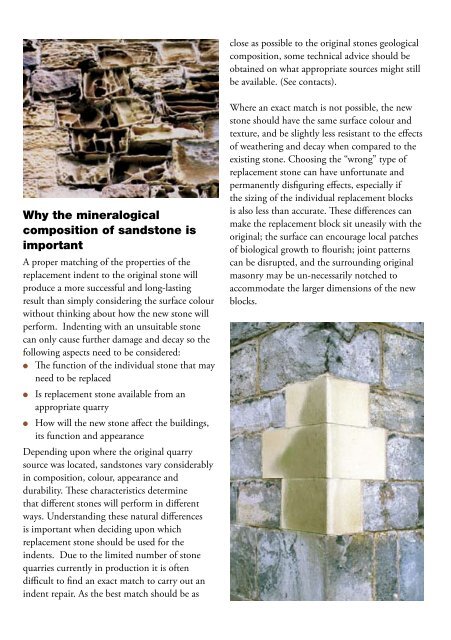Indent Repairs to Sandstone Ashlar Masonry - Historic Scotland
Indent Repairs to Sandstone Ashlar Masonry - Historic Scotland
Indent Repairs to Sandstone Ashlar Masonry - Historic Scotland
Create successful ePaper yourself
Turn your PDF publications into a flip-book with our unique Google optimized e-Paper software.
Why the mineralogical<br />
composition of sands<strong>to</strong>ne is<br />
important<br />
A proper matching of the properties of the<br />
replacement indent <strong>to</strong> the original s<strong>to</strong>ne will<br />
produce a more successful and long-lasting<br />
result than simply considering the surface colour<br />
without thinking about how the new s<strong>to</strong>ne will<br />
perform. <strong>Indent</strong>ing with an unsuitable s<strong>to</strong>ne<br />
can only cause further damage and decay so the<br />
following aspects need <strong>to</strong> be considered:<br />
l The function of the individual s<strong>to</strong>ne that may<br />
need <strong>to</strong> be replaced<br />
l Is replacement s<strong>to</strong>ne available from an<br />
appropriate quarry<br />
l How will the new s<strong>to</strong>ne affect the buildings,<br />
its function and appearance<br />
Depending upon where the original quarry<br />
source was located, sands<strong>to</strong>nes vary considerably<br />
in composition, colour, appearance and<br />
durability. These characteristics determine<br />
that different s<strong>to</strong>nes will perform in different<br />
ways. Understanding these natural differences<br />
is important when deciding upon which<br />
replacement s<strong>to</strong>ne should be used for the<br />
indents. Due <strong>to</strong> the limited number of s<strong>to</strong>ne<br />
quarries currently in production it is often<br />
difficult <strong>to</strong> find an exact match <strong>to</strong> carry out an<br />
indent repair. As the best match should be as<br />
close as possible <strong>to</strong> the original s<strong>to</strong>nes geological<br />
composition, some technical advice should be<br />
obtained on what appropriate sources might still<br />
be available. (See contacts).<br />
Where an exact match is not possible, the new<br />
s<strong>to</strong>ne should have the same surface colour and<br />
texture, and be slightly less resistant <strong>to</strong> the effects<br />
of weathering and decay when compared <strong>to</strong> the<br />
existing s<strong>to</strong>ne. Choosing the “wrong” type of<br />
replacement s<strong>to</strong>ne can have unfortunate and<br />
permanently disfiguring effects, especially if<br />
the sizing of the individual replacement blocks<br />
is also less than accurate. These differences can<br />
make the replacement block sit uneasily with the<br />
original; the surface can encourage local patches<br />
of biological growth <strong>to</strong> flourish; joint patterns<br />
can be disrupted, and the surrounding original<br />
masonry may be un-necessarily notched <strong>to</strong><br />
accommodate the larger dimensions of the new<br />
blocks.













![Elgin Cathedral Wedding Brochure [pdf, 544kb] - Historic Scotland](https://img.yumpu.com/22301571/1/190x151/elgin-cathedral-wedding-brochure-pdf-544kb-historic-scotland.jpg?quality=85)



